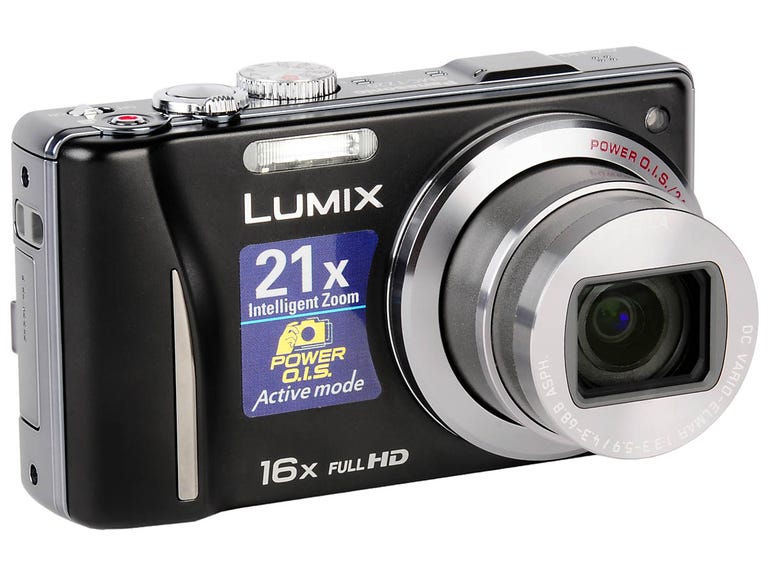 Why You Can Trust CNET
Why You Can Trust CNET Panasonic Lumix DMC-TZ20 review: Panasonic Lumix DMC-TZ20
The Panasonic Lumix DMC-TZ20 compact superzoom is expensive. But its high-quality images, long zoom range, HD movie features, GPS, and touchscreen mean you certainly get plenty of camera for your money.
The Panasonic Lumix DMC-TZ10 was one of our favourite compact superzooms of last year. Beef up the resolution by a couple of megapixels, increase the zoom range, add yet more clever gadgetry, and what have you got? The Panasonic Lumix DMC-TZ20. It's not cheap, at around £300, so let's find out if it's worth saving up for.
The Good
The Bad
The Bottom Line
Tough act to follow
Put the TZ20 next to its predecessor, and you'd be hard-pressed to tell them apart. In fact, there's only one design change that makes any real practical difference -- the dedicated video button has moved from the rear of the unit to a slightly more convenient position on the top edge.

In terms of specs, though, the TZ20 is quite a significant improvement on the TZ10. For a start, there's a new 24mm ultra-wide-angle Leica DC Vario-Elmar lens with a staggering 16x optical zoom. The new lens goes further width- and length-wise than the 12x zoom lens on the TZ10.
The image sensor's resolution, too, has been increased from 12.1 megapixels to 14.1 megapixels. It's also interesting to see that Panasonic has decided to switch from a CCD-type chip to a CMOS sensor instead, which should improve the picture quality, particularly when it comes to filming video clips.
Movie quality has been ramped up to 1080i at 50 frames per second. The TZ20 uses the same AVCHD format to record video as proper, grown-up camcorders, and the camera's zoom and image-stabilisation features are both available during filming. Stereo sound recording and an HDMI output make this an attractive package for film makers.
Built-in GPS is, once again, a notable feature, allowing you to record the co-ordinates where a shot was taken, for example. Panasonic rounds out the TZ20's abilities with a 3-inch touch-sensitive LCD panel and 3D photo-capture capability. All in all, the TZ20 is a highly impressive assemblage of cutting-edge technology.
The shape of things
Available in blue, red, black and silver, the TZ20 isn't the slimmest or lightest camera in the universe. But it's still quite an achievement to cram so much into such a relatively small space.
In terms of its interface, the TZ20 is a curious blend of the traditional and modern. Despite the touchscreen, Panasonic has left most of the physical controls intact. The on-screen menus are navigated by scrolling and selecting using an old-fashioned five-way pad, for example. You can tap the screen to focus, however, and -- if you really want to -- you can zoom using an on-screen control rather than the top-mounted rocker. It's by no means an awful control scheme but it certainly takes some getting used to and the touch element doesn't have the instantly intuitive qualities of, say, the iPhone.
Ten different shooting modes are available, including 'intelligent auto', program AE, 3D, and aperture or shutter priority. There are also customisable scene modes and a full manual setting. These can all be selected via the top-mounted mode dial. Once you've chosen your mode, you can change other settings via the touchscreen, as required.
There are plenty of useful automatic features, such as face detection, red-eye correction, scene selection and so on. The autofocus and other automated settings are quick to adapt too, allowing the device to operate effectively as a shoot-from-the-hip camera. Conversely, enthusiasts will appreciate the wide range of manual settings, effects and tweaks that can be employed and adjusted with relative ease.
Quick on the draw
The TZ20 is fast. It's able to shoot about 2 seconds after you flip the power switch. There's barely any lag between shots, although, if you flip to playback mode straight after you've taken a photo, you may find the camera is still writing data in the background. The camera can capture a zippy 10 frames per second in the continuous-shooting mode.
Shots taken outdoors in the daytime look fantastic. They're punchy, yet offer well-balanced colours and strong contrast. The TZ10 can pick out detail across areas of light and shadow. There's some distortion with the lens at the wide-angle setting, and a small amount of purple fringing in high-contrast areas, but both of these fall well within the norm for a top-end compact.
Sharpness freaks may wish to take the edge off the softness slightly using their image-editing tool of choice. For most people, however, the TZ20's rich, warm image quality will be instantly appealing.
The camera's low-light performance is as good as that of many of the better compacts we've seen recently. Full-resolution, non-flash pictures can be taken at ISOs of right up to 1,600 without too much noise appearing. Still, we found the optimum setting to be ISO 400 or less. Blurring is suppressed by the camera's good optical image stabilisation.
The TZ20's video recordings are a cut above those of most other still cameras. Perfectionists probably won't want to leave their dedicated camcorders at home, but the 1080i quality is ideal for family outings, holiday clips and so on.
The 3D function borders on being a gimmick. The camera doesn't have two lenses, so it takes a series of photos as you pan and then combines the most suitable pair into a 3D composite. You can't view these images back on the screen Nintendo 3DS-style, so you'll need a compatible TV or computer to see them at all. If you have all the requisite hardware and a firm belief that 3D is the future, this feature could be of interest.
The TZ20's main weakness is its battery life. The supplied power pack is good for around 260 pictures, which is 40 less photos per charge compared to the TZ10.
Conclusion
The Panasonic Lumix DMC-TZ20 improves on its predecessor in just about every regard, besides battery life. It's highly versatile, and can capture stunning portraits, landscapes, action shots, videos and more.
You should definitely check out the TZ20 if you're either a gadget nut who wants all the coolest features and strong performance in one device, or an adventurous type who needs an adaptable travel snapper, complete with GPS. Otherwise, we'd suggest thinking about how much you're actually likely to use the TZ20's features before you cough up £300.
Edited by Charles Kloet


